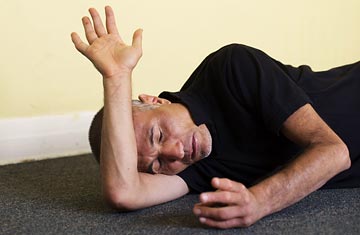September 9th, 2015 by Dr. Val Jones in Health Tips, True Stories
1 Comment »

Photo Cred: Max S. Gerber
I learned a valuable lesson recently about how difficult it can be to make the correct diagnosis when you see a patient for a very short period of time. In the acute rehab setting I admit patients who are recovering from severe, life-altering brain events such as strokes, head injuries, and complex medical illnesses. It is challenging to know what these patients’ usual mental function was prior to their injuries, and so I rely on my knowledge of neuroanatomy, infectious disease, and pharmacology to guide my work up. However, I have learned that asking the patient’s family members about what they were like (in their healthier state) is extremely important as well. Personality quirks, likes and dislikes, and psychiatric history all offer clues to ongoing behavioral challenges and mental status changes.
This fact was never clearer than when I met an elderly gentleman with a new stroke. He was extremely drowsy, non-participatory, and was not oriented to anything but his name. The stroke had occurred in a part of the brain that does not affect cognition, so I began to wonder if he had an infection or was having a reaction to a medication. I carefully ruled out all possible sources of infection, and I combed through his medication list and removed any potentially sedating drugs. His mental status remained unchanged for several days. I then began to wonder if perhaps he was suffering from significant dementia at baseline, and that he was living at home with more help from his family than they had initially reported. The therapy team and I began to consider a transfer to a nursing home. The family was horrified by the idea.
As it turned out, his grandson shared with me that he believed that the patient was autistic. Because his grandpa was elderly, he grew up in a time where not much was known about autism, and diagnoses of the condition was rarely made. He was therefore never formally diagnosed, but had many of the textbook characteristics. His stroke, combined with a sudden transfer to an inpatient hospital setting, was very distressing for the patient, and he had shut down to protect himself from the mental anguish. The “dementia-like” behavior that we were witnessing was merely an acute psychological reaction.
Armed with this new information, the therapy team requested family members to be present during all sessions – to encourage participation and to provide comfort and normalization of the transition from home to hospital. The patient responded beautifully, and made remarkable gains in his ability to walk and participate in self care activities.
I apologized profusely to the family for our period of confusion about his diagnosis and care needs, and offered reassurance that we would do our very best to help him recover from his stroke so that he could go home directly from the hospital. He did in fact return home, and with a little extra help from his daughters, he is enjoying his usual projects and activities.
As for me, I will never presume dementia without careful family confirmation again.
June 16th, 2014 by Dr. Val Jones in Health Policy, Health Tips
No Comments »

Occupational Therapy Environment, Saint Luke's Hospital, WA
For most physicians who practice inpatient medicine, acute inpatient rehabilitation facilities are mysterious places with inscrutable admissions criteria. This is partly because physical medicine and rehabilitation (PM&R) has done the poorest job of public relations of any single medical specialty (Does anyone know what we do?), and also because rehab units have been in the cross hairs of federal funding cuts for decades. The restrictive CMS criteria for inpatient rehabilitation have resulted in contortionist attempts to practice our craft in an environment where clinical judgment has been sidelined by meticulous ICD-9 coding.
But I will not bore you with the reasons behind our seemingly capricious admissions criteria. Instead I will simply tell you what they are in the simplest way possible. After much consideration, I thought it would be easiest to start with the contraindications to acute rehab – I call these “red lights.” If your patients have any of these, then they will not qualify for transfer to the acute inpatient rehab unit. I followed the absolute contraindications with relative contraindications (you guessed it, “yellow lights”) – these patients require some clinical and administrative judgment. And finally, I’ve listed the official green lights – the diagnosis codes and medical necessity rules for the ideal inpatient rehab candidate.
I hope that these rules demystify the process – and can help discharge planners, rehab admissions coordinators, and acute care attending physicians alike help to get the right patients to acute inpatient rehab.
RED LIGHT (Patient does not meet criteria, admission is not currently indicated):
- Inability to Participate: Patient cannot tolerate 3 hours of therapy per day.
- Unwillingness to participate: The patient does not wish to participate in PT/OT/speech therapies and/or shows no evidence of motivation in previous attempts to perform therapy
- Poor rehabilitation potential: The patient’s functional status is currently no different than their usual baseline. (Confirmed by previous history, medical records, or reliable source.)
- Dementia: The patient has a chronic brain deficiency that is not expected to improve and makes carryover of training unlikely or impossible.
- Doesn’t need help from at least 2 different rehab disciplines: The patient must demonstrate likely benefit from working with at least 2 of these: PT, OT, Speech.
- Acute illness or condition: The patient has an acute illness/condition requiring medical intervention prior to transfer to an acute rehab facility – these include:
- septicemia (infection with fever and elevated white count)
- delirium (medication effect, dehydration, infectious, toxic-metabolic)
- unstable vital signs (severe hyper or hypotension, severe tachy or brady arrhythmia, hypoxia despite oxygen supplementation)
- acute psychotic episode (including active hallucinations or delusions)
- uncontrolled pain (the patient’s pain is not sufficiently controlled to allow participation in therapy)
- severe anemia
- extreme fatigue or lethargy due to medical condition
- Procedure or workup pending: The patient is in the middle of a work up for DVT, cardiac disorder, stroke, infection, anemia, chest pain, bleeding, etc. or is about to undergo a procedure (surgery, imaging study, interventional or lab test) that could alter the immediate course of his/her medical/surgical management.
YELLOW LIGHT (The patient may not be a good rehab candidate, clinical/administrative judgment required regarding admission):
- Possible poor rehabilitation potential: The patient’s prior level of function (PLOF) is likely low or similar to current level, however there is no clear documentation of the patient’s PLOF. It is unclear if aggressive rehabilitation will substantially improve the patient’s functional independence.
- Unclear benefit of ARU versus SNF: The patient is unlikely to avoid future placement at a skilled nursing facility. Would it be in the patient’s best interest to transfer there directly?
- Mild dementia or chronic cognitive impairment: The patient has carryover challenges but is able to participate and follow directions. There may be family members who could benefit from PT/OT/Speech training so they can take the patient home and be his/her caregiver(s).
- Unclear safe discharge plan: The patient lives alone or has no family support or has no financial means to improve their living conditions or their home is unfit for living/safe discharge or patient refusing SNF but qualifies otherwise.
- Insurance denial: The patient’s insurer declines their inpatient rehab stay. Physiatrist may attempt to overturn decision or facility may wish to take patient on a pro bono status. Uninsured patients may be candidates for emergency Medicaid. Facility must decide if they will lobby for it.
- Severe behavioral disorders (unrelated to acute TBI): Verbally abusive, violent, inappropriate or disruptive to other patients.
- The patient meets medical necessity criteria for acute inpatient rehab but their impairment is not represented by one of the 13 impairment categories approved by CMS. (E.g. medical debility, cardiac impairment, pulmonary disease, cancers, or orthopedic injury without required comorbidities). Admission may depend upon individual facility’s case mix and its current annual compliance rate with 60% rule.
GREEN LIGHT (The patient is a good candidate for acute inpatient rehab if they have no red or yellow lights, meet criteria for medical necessity AND meet the impairment categories listed below):
MEDICAL NECESSITY DEFINITION:
Acute inpatient rehabilitation services are medically necessary when all of the following are present:
- Individual has a new (acute) medical condition or an acute exacerbation of a chronic condition that has resulted in a significant decrease in functional ability such that they cannot adequately recover in a less intensive setting; AND
- Individual’s overall medical condition and medical needs either identify a risk for medical instability or a requirement for physician and other personnel involvement generally not available outside the hospital inpatient setting; AND
- Individual requires an intensive inter-disciplinary, coordinated rehabilitation program (as defined in the description of service) with a minimum of three (3) hours active participation daily; AND
- Individual is medically stable enough to no longer require the services of a medical/surgical inpatient setting; AND
- The individual is capable of actively participating in a rehabilitation program, as evidenced by a mental status demonstrating responsiveness to verbal, visual, and/or tactile stimuli and ability to follow simple commands. For additional information regarding cognitive status, please refer to the Rancho Los Amigos Cognitive Scale (Appendix B); AND
- Individual’s mental and physical condition prior to the illness or injury indicates there is significant potential for improvement; (See Note below) AND
- Individual is expected to show measurable functional improvement within a maximum of seven (7) to fourteen (14) days (depending on the underlying diagnosis/medical condition) of admission to the inpatient rehabilitation program; AND
- The necessary rehabilitation services will be prescribed by a physician, and require close medical supervision and skilled nursing care with the 24-hour availability of a nurse and physician who are skilled in the area of rehabilitation medicine; AND
- Therapy includes discharge plan.
13 Diagnosis Codes Approved by CMS for Acute Inpatient Rehab
1. Stroke
2. Spinal cord injury
3. Congenital deformity
4. Amputation
5. Major multiple trauma
6. Fracture of femur (hip fracture)
7. Brain injury
8. Neurological disorders, including:
• Multiple sclerosis
• Motor neuron diseases (Guillain Barre, ALS)
• Polyneuropathy
• Muscular dystrophy
• Parkinson’s disease
9. Burns
10. Arthritis: Active polyarticular rheumatoid arthritis, psoriatic arthritis, and seronegative arthropathies
resulting in significant functional impairment of ambulation and other activities of daily living;
11. Vasculitis: Systemic vasculidities with joint inflammation resulting in significant functional impairment of ambulation and other activities of daily living
12. Severe or advanced osteoarthritis (osteoarthrosis or degenerative joint disease) involving two or more weight bearing joints (elbow, shoulders, hips, or knees but not counting a joint with a prosthesis) with joint deformity and substantial loss of range of motion, atrophy of muscles surrounding the joint, and significant functional impairment of ambulation and other activities of daily living
13. Knee or hip joint replacement, or both, during an acute care hospitalization immediately preceding the inpatient rehabilitation stay and also meets one or more of the following specific criteria:
- The patient underwent bilateral knee or bilateral hip joint replacement surgery during the acute care hospital admission immediately preceding the IRF admission
- The patient is extremely obese with a Body Mass Index of at least 50 at the time of admission to the IRF or
- The patient is age 85 or older at the time of admission to the IRF.
References:
http://www.anthem.com/medicalpolicies/guidelines/gl_pw_a051177.htm
https://www.cms.gov/Outreach-and-Education/Medicare-Learning-Network-MLN/MLNProducts/downloads/InpatRehabPaymtfctsht09-508.pdf
http://www.gpo.gov/fdsys/pkg/FR-2013-08-06/pdf/2013-18770.pdf












